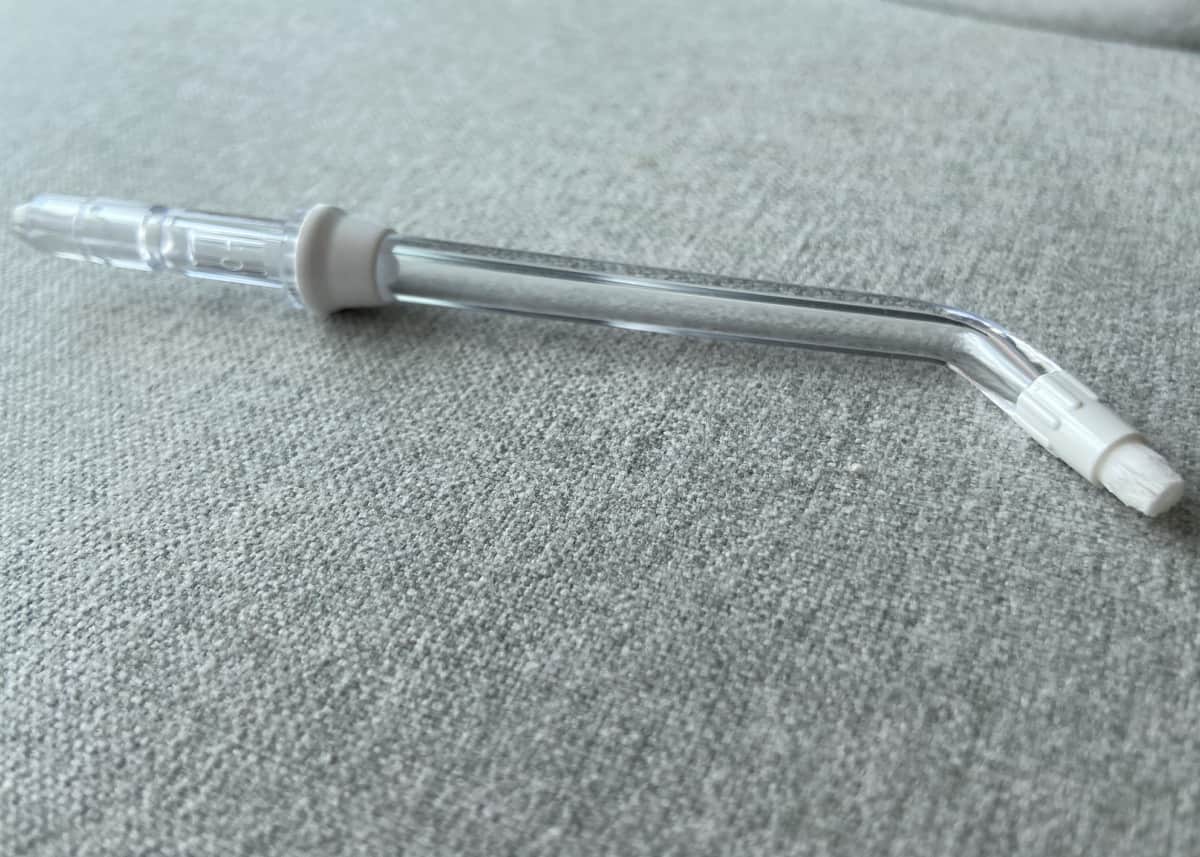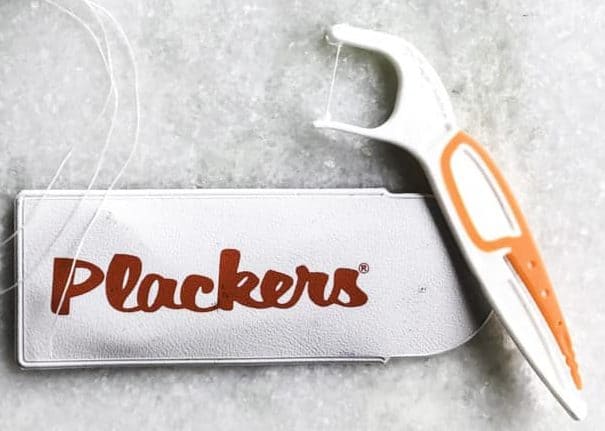
Orthodontics is becoming a much more popular treatment because of advancements in technology, affordability and the increasing awareness about how a straight and healthy smile positively impacts our overall health. I have many patients that sit in my dental chair who ask me about different products/tools that will help them maintain their oral health during orthodontic treatment.
Waterpik offers benefits that flossing cannot provide. Using the orthodontic tip, the Waterpik will clean the brackets where floss cannot reach. Floss will clean between the teeth and under the gumline, where the Waterpik is not as effective as floss.
There are pros and cons to every single dental hygiene tool out there on the market. That’s why we don’t only brush our teeth with a toothbrush, we use toothpaste and (hopefully) use floss as well. Using an arsenal of dental hygiene tools will allow you to achieve the best oral health possible.
In this post, I go over the pros and cons of both the Waterpik and floss. I also touch on if you can use a Waterpik instead of flossing with braces, why using these tools is important, and a few other common questions I get from my patients!
Pros and Cons of Waterpik and Floss
There are pros and cons to every product, and learning what they are will help you make an informed decision. My professional recommendation is to use both floss and the Waterpik, but I know it can seem overwhelming to use both.
I always encourage my patients to do their best and pick a tool that they will actually use and won’t just sit on their bathroom countertop.
If you are interested in other products that are great to use for braces, I put together a resource page of all the things that got me through my own orthodontic treatment (I went through it twice) and the products I WOULD NOT LIVE without! You can find the link to that page below.
Holly’s Orthodontic Resources Page ☺️
Pros of Waterpik
The reason I love the Waterpik so much is that it’s easy to use and is incredibly effective. I have had patients whose oral hygiene was very poor, but after discussing with them the benefits of a Waterpik, they purchased one, and the next time I saw them, I couldn’t believe my eyes at the improvement!
The best thing about the Waterpik is the interchangeable tips and they make one specifically for braces. It is called the orthodontic tip.

The orthodontic tip is specific for the bracket-style of braces! I recommend it to every patient that I have who is thinking about going through with braces, has braces, or parents who have kids with braces.
The orthodontic tip bristles are tapered to fit around the brackets perfectly, getting places even a toothbrush cannot get at. Remember to clean all 5 surfaces of the brackets (4 sides and one front surface)!
This tip can also be used on orthodontic appliances such as space maintainers and palate expanders.
You can find the link to this tip on Holly’s Orthodontic Resources Page ☺️.
Another positive thing about using a Waterpik is that it is quick and easy to use. For people on a time crunch, mobility issues, and those who won’t floss, the Waterpik should be incorporated into your routine ASAP.
This study evaluated the addition of a Waterpik to brushing with a manual toothbrush on gum health. It’s a great study that shows the Waterpik improves gum health when compared to using a manual toothbrush alone.
evaluated the addition of a Waterpik to brushing with a manual toothbrush on gum health. It’s a great study that shows the Waterpik improves gum health when compared to using a manual toothbrush alone.
To recap on the pros of Waterpik;
– Interchangeable tips for different uses
– Reaches areas floss cannot. For example; around brackets, space maintainers, palate expanders
– Quick and easy to use
– Improves gum health
Cons of Waterpik
There aren’t too many cons of the Waterpik, to be honest. When I discuss the Waterpik with patients in my dental chair, I always mention that it does not replace flossing. I don’t like how it’s marketed as a water flosser because it can be interpreted by the consumer as a replacement for floss.
For me, absolute transparency is so important, especially when it comes to advertising/marketing strategies by dental product companies. But nonetheless, it is a great tool!
To remove the sticky plaque on your teeth, you need to mechanically remove it by brushing and flossing. Waterpiks are an adjunctive therapy only. Please try to floss regularly at least 3-4 days a week, but try to get 7 days a week!
Another con is that the bristles on the Waterpik tips do not reach in between the teeth and under the gumline as flossing and brushing do. This will mean that there are surfaces not being cleaned properly, allowing the bacteria in the mouth to proliferate, increasing the potential for cavities and gum disease.
To recap on the cons of Waterpik;
– Does not replace flossing and brushing
– The bristles of the orthodontic tip cannot reach in between the teeth and under the gumline as floss does
Pros of Flossing
Flossing is so beneficial to the health of the gums. When you don’t floss, the bacteria will continue to multiply, both increasing the amount of acid that is produced, and the number of bacteria the body has to try and fight off.
By not removing the bacteria regularly, gingivitis and periodontal disease (gum disease) can occur and cavities can start forming.
When you have braces, there is much more surface area for the bacteria to adhere to, more areas that will catch food that will feed the bacteria and cause more issues (cavities and gum disease), and it is harder to keep your teeth and gums clean. That is why flossing becomes even more important during orthodontic treatment.
Floss mechanically removes plaque off the teeth. The analogy I tell my patients is;
Imagine a dirty plate that has food stuck to it, such as egg yolk. You can’t just run it underwater to get all the stuck-on food off the plate, you need to use a scrubber to mechanically get it off.
To recap on the pros of flossing;
– Helps to prevent cavities and gum disease
– Mechanically removes bacteria and food from the teeth and under the gum tissue
Cons of Flossing
Flossing when you have braces on your teeth can be a painstaking ordeal. I absolutely hated flossing when I had braces (twice), and I still hate flossing around my lingual wire (permanent retainer on the inside of lower front teeth). But because I know the consequences of not flossing, I endure it. However, flossing still has its downfalls.
Flossing cannot reach well around the brackets and clean the brackets themselves. And not to mention hard to do around braces.
To make it an easier process, Plackers made a floss pick that has one really thin end for it to slide underneath the wire of the braces to floss between the teeth! They are literally one of the best tools invented in recent years for braces!

The floss picks by Plackers for braces are called “Orthopik” and you can find them linked below! They even have a bendable soft pick at the end (it’s orange in colour).
Sometimes, depending on the thickness of the wire, and the position of the bracket on the tooth, the ortho floss pick may not fit under that well. Don’t force it through if it doesn’t fit.
To recap on the cons of flossing;
– Cannot clean around the brackets effectively
– Can be difficult to do properly and time-consuming with braces
Invisalign vs traditional bracket-style braces and oral hygiene routine
The beauty of Invisalign is you can take out your plastic trays to maintain a healthy oral hygiene routine. The toothbrush will effectively clean around the Invisalign buttons, and flossing can be done easily with regular string floss or floss picks.
Read Now: Plackers vs String Floss: Do Picks Work as Well as String?
Invisalign is a fantastic option for those looking for a more discrete treatment and easily maintain their oral hygiene.
Traditional brackets are harder to keep clean but are sometimes the better choice depending on the treatment plan and patient compliance. Invisalign is not an ideal treatment if you cannot wear the trays for at least 22-23 hours a day.
Use an electric toothbrush
Using an electric toothbrush has been proven to be so much more effective than using a manual toothbrush. I will never go back to using a manual toothbrush. I have seen the benefits and testimonials straight handed from my patients in my dental chair.
Especially when going through orthodontic treatment, you want all the help you can get! You can read all the benefits of an electric toothbrush in the link below! You will never want to go back to using a manual toothbrush!
Read now: 12 Benefits of Using an Electric Toothbrush
Oral-B orthodontic toothbrush head for electric toothbrush
Speaking of electric toothbrushes… in a similar fashion to the Waterpik, you can purchase different heads/tips that tailor to your specific needs.
Oral-B has an electric brush head specifically designed for braces! I wish I had this while going through my own treatment! You can find the Oral-B orthodontic brush head linked below! 🙂
If you are looking to have the best optimal oral health you can while going through orthodontic treatment, I recommend using an Oral-B electric toothbrush with the orthodontic brush head in your oral hygiene routine.
Can I use a Waterpik instead of flossing with braces?
A Waterpik can be used instead of flossing with braces. However, it is recommended to use both the Waterpik with the orthodontic tip and floss, along with regular brushing to maintain oral health.
It comes down to compliance. If you will not floss, the Waterpik is the next best choice. I would rather you use something rather than nothing (or even sporadically).
I have seen so many times the all-or-nothing mentality of people who start flossing, and they are doing so well with flossing daily, then they miss a couple of days in a row and throw in the towel. They say, oh well I’ve missed a few days so I might as well not do it. I have been there myself!
Can I put Listerine in my Waterpik?
You can put Listerine in the Waterpik in small amounts. It is important to note that it will have no effect on the teeth and gums as it will be too diluted. It acts as a flavour enhancer and can increase user compliance. Ensure to flush out the machine with plain water after Listerine use.
Is it OK to not floss with braces?
It is not okay to not floss when going through orthodontic treatment with braces. By not flossing, cavities and gum disease can become more prevalent, leading to more serious dental complications.
The best routine to take care of your braces is below!
You want to use these tools in this order:
- Floss first
- Waterpik
- Brush. And after you are done brushing, I know it will sound gross, but I don’t want you to rinse your mouth out after brushing
- Just spit!
If you rinse your mouth out after brushing, you will rinse away pretty much all the active ingredients in the toothpaste that prevent cavities and tooth sensitivity.
Having braces can increase the incidence of cavities because it is much more difficult to remove cavity-causing bacteria from the mouth. So avoiding rinsing or eating or drinking for 30 minutes after brushing will give you a lot more protection from cavities and sensitivity.
I really hope this information has helped you and encouraged you to maintain your oral health!
I hope you have a great day,
Holly 🙂

